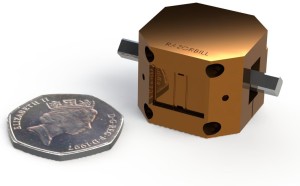Low-temperature nano-manipulators
Nano-manipulators have many uses in academic research, scanning probe microscopy, the biomedical and aerospace sectors, and nanofabrication. Important industrial processes such as circuit manufacture are shifting towards nano-manipulation, and the nano-tools market is currently worth around £4 billion.

In 2014, three St Andrews physicists - Alexander Ward, Jack Barraclough and Clifford Hicks (now at MPI Dresden) - founded Razorbill Instruments to commercialise a new generation of nano-manipulators. The company was set up initially to commercialise a cryogenic strain cell developed by Hicks, used to study the properties of superconductors under an applied strain. The original research, undertaken in St Andrews, was published in the journal Science: Hicks et al. Science Vol. 344, Issue 6181, pp. 283-285. The team won seedcorn funding from Converge Challenge, Scottish Enterprise, and a Royal Society Enterprise Fellowship for Managing Director Alex Ward. In 2015, Razorbill Instruments Ltd. relocated to the Higgs Centre for Innovation in Edinburgh.

Alexander Ward, Razorbill's Managing Director. Picture by Iain Stewert Photography.
The company now sells a range of nanopositioning products that can deliver precise and reliable nanoscale movement, with a wide range of applications in microscopy and nanofabrication. For example, their ZED-CAP miniature high-precision displacement sensors are used in a prototype cubesat nanosatellite, built by the UK Astronomy Technology Centre, to precisely align the unfolding petals of a telescope mirror.